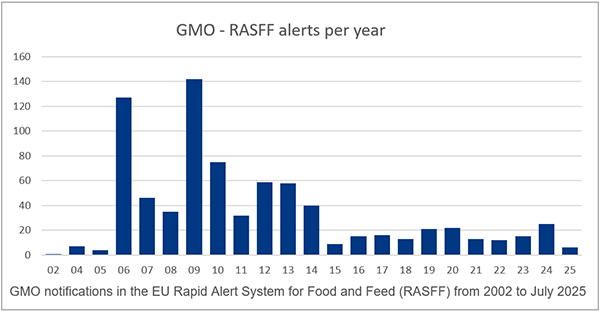Challenges and trends in international GMO monitoring

Why origin and target market determine the analysis strategy
August 2025. Different regulations on the handling of genetically modified organisms (GMOs) present a particular challenge in the international trade of food and feed. Asynchronous approvals, inconsistent or absent monitoring approaches and divergent labelling requirements increase the risk of GMOs entering the supply chain unintentionally. Official controls and analyses by private laboratories are therefore essential to ensure product quality.
Challenges posed by asynchronous GMO approvals
Asynchronous approval occurs when a GMO has been approved in one country, possibly also for cultivation, but has not yet been approved in another country. Such differences in approval status mean that products containing GMO components may be marketable and already commercialised in one region while they are not yet permitted for sale in other countries.
Given asynchronous approvals and differing monitoring approaches, there is a risk that GMOs that are not yet approved in the respective marketing region may enter the food or feed chain through cross-border trade. This can jeopardise the marketability and marketing of the products concerned. In addition, the unintentional admixture of approved GMOs can lead to a labeling requirement for the end product if the raw materials used have an elevated GMO content.
Seed and harvest monitoring for genetic contamination
In countries without commercial GMO cultivation, the focus is often on providing GMO-free seeds, the purity of which is verified through targeted monitoring programmes. One example of this is the GMO monitoring of seeds by the Austrian Federal Agency for Food Safety (BAES), which found traces of a GMO in only one sample in recent years[1]. Harvested products are also checked for GMO-free status as part of the corresponding programmes. Consistent monitoring of seeds significantly contributes to ensuring that no GMOs are detected in harvested products in the respective growing regions[2].
However, in countries where a high proportion of genetically modified crops are grown, seed testing is sometimes not carried out at all, or only irregularly. Furthermore, there are countries where genetically modified crops are cultivated despite there being no permits for them. Without structured monitoring to record and document potential contamination, there is an increased risk that raw materials from such countries may unintentionally contain GMO components. One example of this is Ukraine: a report by the Global Agricultural Information Network (GAIN) refers to positive test results for corn, rapeseed, and soybeans in export facilities, which indicate undeclared cultivation of genetically modified plants[3].
Official food and feed controls for GMOs in the EU
EU Member States are required to carry out official controls to ensure compliance with legal requirements. This includes regulations on the labelling of GMOs in food, feed, and seeds. These obligations are described in Regulation (EC) 882/2004 and Regulation (EU) 2017/625[4,5]. In Germany, GMO monitoring is coordinated by the Federal Office of Consumer Protection and Food Safety (BVL) in cooperation with the state authorities.
The Croatian Agency for Agriculture and Food (HAPIH), which is responsible for GMO monitoring in Croatia, recently published the results of a feed monitoring programme for genetically modified soybeans[6]. According to the report, all feed samples tested between 2019 and 2024 contained genetically modified soy, with one exception. By contrast, a food monitoring study conducted by the same authority between 2018 and 2022 found that only 20 of a total of 742 samples tested positive for approved genetically modified soy[7].
GMO findings in the RASFF Rapid Alert System

Figure 1
In accordance with EU requirements, the results of official tests indicating the presence of unauthorised GMOs must be reported via the Rapid Alert System for Food and Feed (RASFF). Figure 1 shows the number of rapid alerts relating to GMO findings in recent years. Over the last ten years, the number of notifications has remained at a consistently low level. This can be attributed to established control systems and reliable analysis methods, among other things.
Trends: Increasing diversity of detection methods
As stated in the 2025 publication by Pandžić et al., there has been an increase in the number of detection methods required for the effective monitoring of genetically modified organisms. New screening strategies and specific detection methods have been developed to improve the significance of the analyses[6].
Contact us
Depending on the origin of the raw materials and the country of destination of the products, different regulatory requirements and detection methods must be taken into account. We provide comprehensive expert advice to help you select the right analyses for your individual needs.
For further information or if you have any questions about GMO analysis, please contact your personal account manager or get in touch with our GMO expert Ulf Rathjens directly.
Sources
[1] Austrian Federal Office for Food Safety (BAES) Annual reports GMO monitoring and surveillance in seeds 2013 – 2024
[2] GMO crop monitoring in Baden-Württemberg (in German)
[3] United States Department of Agriculture, Global Agricultural Information Network, country Ukraine 20024; UP2024-0023: Biotechnology and Other New Production Technologies Annual
[4] Regulation (EC) No 882/2004 of the European Parliament and of the Council of 29 April 2004
[5] Regulation (EC) No 2017/625 of the European Parliament and of the Council of 15 March 2017
[6] Pandžić, Katarina & Steiner, Zvonimir & Radovic, C. & Duka, Ksenija & Gantner, Vesna. (2025). Monitoring and Detection of Genetically Modified Soybean in Animan Feed using real time PCR (2019-2024). Biotechnology in Animal Husbandry. 41. 57-66. 10.2298/BAH2501057P.
[7] Renata (2023) Monitoring of Genetically Modified Food on the Croatian Market from 2018 to 2022, International Conference on GMO Analysis and New Genomic Techniques, Poster


